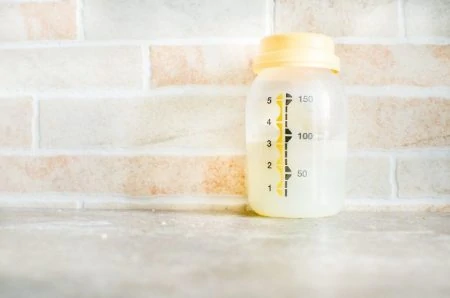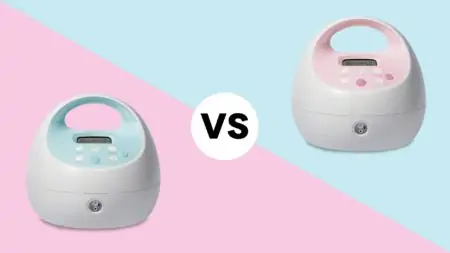Panic sets in. Is it safe? Is something wrong with you or the baby?
Take a deep breath. You aren’t alone. We have experienced this exact moment of shock, and we know how unsettling it feels when your body does something unpredictable.
Rainbow shades in your breast milk are usually harmless, but it helps to know the “why” behind the color. We consulted with medical experts to break down what’s normal, why colors shift, and when you actually need to call the doctor.
Key Takeaways
- Breast milk changes color frequently based on diet, hydration, and the stage of lactation (colostrum vs. mature milk).
- Yellow or golden milk is normal in the first few days (colostrum) or at the end of a feeding (hindmilk).
- Green, pink, or blue tints are often caused by foods (like spinach or beets), drinks, or foremilk composition, and are generally safe.
- Consult a doctor if you see red milk persisting for more than a few days, or if discharge occurs when you are not lactating.
Why Is My Breast Milk Changing Color?
Seeing a spectrum of colors in your bottle or pump parts is completely normal. While it is surprising (and sometimes a little gross), it is rarely a medical emergency.
When I first started breastfeeding, nobody told me my milk might look like skim milk one day and melted ice cream the next. I worried constantly. Once I started talking to other moms and lactation consultants, I realized that breast milk is a living substance. It changes day to day, and even hour to hour.
There are distinct phases of lactation and dietary factors that influence these shades. By understanding them, you can feel confident about what you are feeding your little one.
The Phases of Breast Milk
As your baby grows, their nutritional needs shift. Your body is smart enough to adjust the milk composition to match. In the first few weeks alone, you will likely see three distinct color changes.
Here is what you can expect as your milk comes in and matures:
1. Colostrum
For the first few days after birth, your body produces “liquid gold.” This is colostrum. It is highly concentrated, nutrient-dense, and low in volume. It usually appears golden yellow or orange, though it can sometimes look clear.
2. Transitional Milk
Between day 2 and day 14, your milk production ramps up. You will notice the yellow colostrum mixing with whiter liquid. This “transitional milk” marks the shift toward mature milk production (1).
3. Mature Milk
Once your supply is established, your milk generally looks white or creamy. However, even mature milk changes during a single feeding session.
4. Foremilk
This is the milk that flows at the start of a feed. It is higher in water and lactose to hydrate your baby. Foremilk is thinner and often looks clear, skim-milk white, or even bluish.
5. Hindmilk
As the breast empties, the fat content increases. This is the “hindmilk.” It looks creamier, thicker, and often darker white or yellow compared to the watery foremilk.
Pink, Red, or Rust-Colored Milk
If you look down and see pink or reddish milk, it is easy to assume the worst. However, rosy or rusty brown tones are usually caused by one of two things: food or trace amounts of blood.
Blood in Breast Milk
“Rusty Pipe Syndrome” is a condition where vascular engorgement causes a little blood to leak into the milk ducts. It often happens when your milk first comes in.
Cracked, dry nipples or a poor latch can also cause bleeding. The good news? It is generally safe to feed this milk to your baby. A little blood won’t hurt them, though it might make their poop look a bit darker later.
Dietary Causes
Did you eat beets, red velvet cake, or foods with red dye recently? Highly pigmented foods can tint your milk pink or orange.
Note: If the red color persists for more than a week, or if you have breast pain and fever, contact your doctor to rule out infection or other issues.
What if My Milk Is Green?
Green breast milk looks shocking, almost like a kale smoothie. Rest assured, there is no evidence that green-tinted milk is harmful.
It is almost always caused by what you ate or drank:
- Leafy Greens: Eating a massive salad or lots of spinach, kelp, or seaweed can dye your milk green.
- Sports Drinks: Blue or green Gatorade contains dyes that pass through to your milk quickly.
- Supplements: Certain vitamins, large doses of iron, or herbal supplements can cause a greenish hue.
Black or Brown Breast Milk
While rare, black or dark brown milk can occur. This is usually linked to a specific medication called Minocycline (Minocin), an antibiotic often used to treat acne.
If you are taking Minocycline and notice your milk turning black, speak to your doctor immediately. While the color itself is startling, you generally should not breastfeed while taking this specific medication without medical clearance.
When Should I Be Concerned?
If your baby is happy, gaining weight, and making plenty of wet diapers, the color of your milk is likely just a cosmetic quirk.
If you were feeding directly and not expressing milk, you’d never even know about your breast milk color changes.
Editor's Note:
Michelle Roth, BA, IBCLCHowever, watch for behavior changes. If your milk is pink (from soda or junk food dyes) and your baby is fussy, gassy, or crying after feeding, it might be a reaction to the ingredients in your diet rather than the color itself.
Mastitis and Clogged Ducts
Sometimes, color changes come with texture changes. Clogged ducts or mastitis can cause milk to thicken or look clumpy.
You might see “strings” of thickened milk or even a bit of pus if an infection is present. While this sounds unappealing, the antibodies in your milk actually protect the baby. You should continue to breastfeed or pump to clear the blockage.
As a clog releases, you might see a burst of yellow, fatty milk or a “string” come out. This is a sign that the milk flow is being restored. To prevent this:
- Feed frequently to keep breasts empty.
- Massage the breast during feeding.
- Check your pump parts to ensure good suction.
- Avoid tight bras or clothing that restricts flow.
Color Changes When Baby Is Sick
Your body is essentially a smart pharmacy. When your baby nurses, their saliva interacts with your nipple receptors. If your baby is sick, your body detects the pathogens and produces specific antibodies to fight that illness.
This immune response can change the color and consistency of your milk, often making it more yellow or colostrum-like. It is a brilliant biological feedback loop that helps your baby recover faster.
Yellow Breast Milk While Weaning
When you decide to wean your toddler, your milk undergoes a process called involution.
As production shuts down, the remaining milk becomes saltier and more concentrated, often turning yellow or transparent. You might notice dried yellow crumbles on your nursing bra. This is totally natural.
Important Warning: If you are not pregnant, nursing, or weaning, and you experience spontaneous discharge from your nipples (especially if it is bloody), see a doctor. This could signal a hormonal issue or other health concerns.
Milk Changes Color in Storage
Pumping milk to use later? You might notice it looks different after sitting in the fridge or freezer.
- Separation: Breast milk is not homogenized. The fat rises to the top, looking yellow or white, while the bottom looks watery and blue. This is normal. Just swirl (don’t shake) the bottle to mix it before feeding.
- Freezing: Frozen milk often looks more yellow than fresh milk.
- High Lipase: Some moms have high lipase activity, which causes the milk to smell soapy or metallic after storage. It is safe to drink, though some babies dislike the taste.











